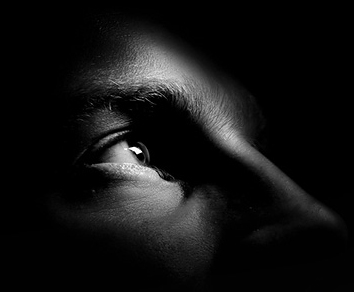






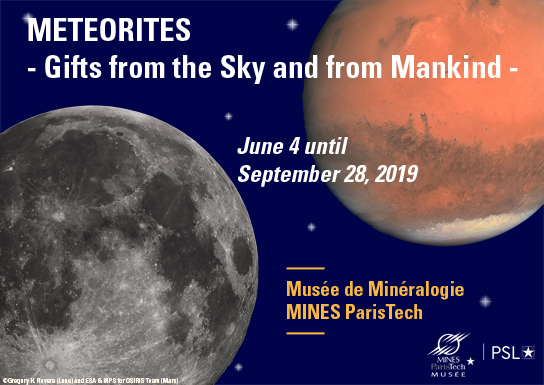
The exhibition “Meteorites - gifts from the sky and from Mankind” brings together exceptional meteorites: fragments of Lunar and Martian meteorites, pallasites, siderites, chondrites, and others. The meteorites on display also show the stories of important donors of the museum. Without such people, the present collection would not be what it is.
This presentation is a small-scale display that includes 2 display cases and 2 touchable specimens, on top of the pre-existing displays of over 50 meteorites.
Important personalities of the mid 19th century are represented thanks to their donations to our museum: Daubrée, Adam, Bertrand, Coxe, Domeyko, Brezina or Lambotin. All played an important part in the history of sciences, mineralogy, and in the history of the School of Mines itself.
In the exhibit, another must-see is the 226-kilogram (500-pound) fragment of the Canyon Diablo meteorite. This meteorite was given in 1891 by Eckley Coxe, an American graduate of the School of Mines. The curator of that time, Friedel, analyzed that meteorite and showed the presence of micro-diamonds, that he reported in a publication at the French Academy of Sciences in 1892.
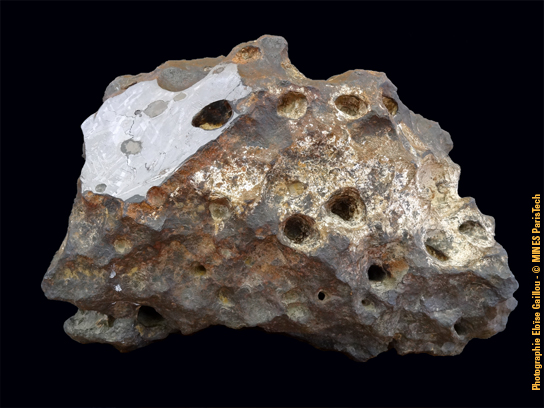 This impressive meteorite fragment of Canyon Diablo meteorite (# 10870, 48 x 37 x 35 cm, 226.80 kg) was donated by Eckley Coxe in 1891.
This impressive meteorite fragment of Canyon Diablo meteorite (# 10870, 48 x 37 x 35 cm, 226.80 kg) was donated by Eckley Coxe in 1891.
Always wanted to touch the Moon or Mars? It is possible at our Museum! Some fragments of lunar and martian meteorites are on display, including two touchable specimens. The displays including the meteorites was made possible thanks to recent donations by Luc Labenne, Alain Carion and Edwin Thompson, who are meteorite hunters, as well as the ABC Mines association, which supports the collection of the Mineralogy Museum MINES ParisTech. The display itself was sponsored by the MINES ParisTech foundation, thanks to a monetary gift by Cédric Denis-Remis.
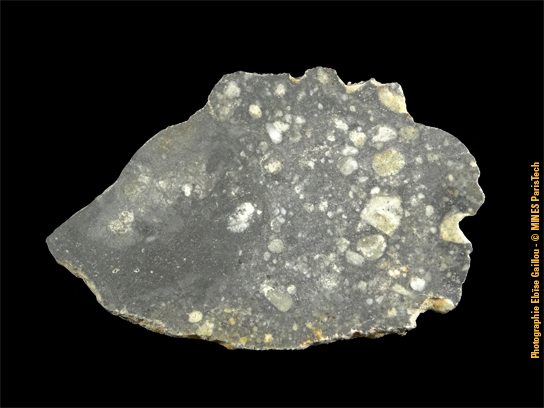 Discovered in 2017 in the Sahara desert by a nomad, the brecciatic lunar meteorite NWA 11472 was acquired by Luc Labenne (#83523; 5.5 x 3.6 x 0.2 cm, 8.98g). The slices made in this meteorite are characteristic, with clear fragments of anorthite, olivine, and pyroxene in a dark feldspathic matrix.
Discovered in 2017 in the Sahara desert by a nomad, the brecciatic lunar meteorite NWA 11472 was acquired by Luc Labenne (#83523; 5.5 x 3.6 x 0.2 cm, 8.98g). The slices made in this meteorite are characteristic, with clear fragments of anorthite, olivine, and pyroxene in a dark feldspathic matrix.
Internal part of Martian meteorite NWA 8656, given by ABC Mines (# 83439, 2.9 x 2.6 x 1.3 cm, 9.88g). This Martian meteorite belongs to the group of shergottites with a so-called diabasic texture. The rock consists mainly of clinopyroxene crystals and maskelynite (shocked plagioclase).
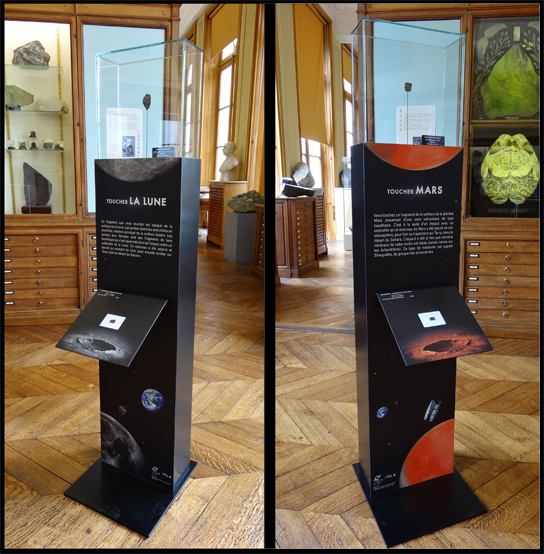
This small-scale exhibition covers a wide variety of meteorites, interesting for the history and stories behind it, as well as for the science they tell. Here is a small selection of them.
- LA CAILLE - SIDERITE, ungrouped
Most likely in the 17th century, a 626 kg iron mass was discovered during a violent storm on the Audibergue mountain, near Caille in the region of Alpes-Maritimes. It was then transported by 4 oxen to the village of Caille near the church, where it served as a bench for more than 2 centuries. Two other iron blocks were also found and delivered to the village’s blacksmith to make horseshoes.
In 1828, the Academy of Sciences retrieved the meteorite for the Museum of Natural History in exchange for the renovation of the church’s bell tower.
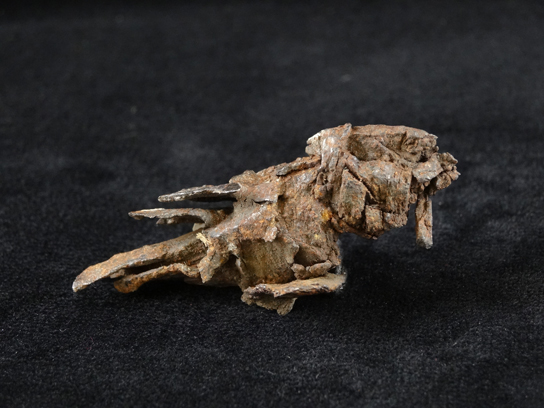
- BARBOTAN - CHONDRITE H5
On Saturday July 24, 1790 at around 9.30 pm, in Barbotan, Gers, onlookers observed in the blue and quiet sky a fireball that exploded into many pieces, followed 3 minutes later by a loud detonation. The fireball was even observed as far as Limoges, 260 km away. 10 kg of rock fragments were found about ten kilometers from Barbotan. At that time, the existence of "rocks that had fallen from the sky" was still highly controversial. It was only in 1803 with the observed fall of the meteorite of the Eagle, in the Orne, that the phenomenon was truly confirmed.
- LA BECASSE– CHONDRITE L6
On January 31, 1879, at about 12:30p.m., a detonation was heard near Dun-le-Poëllier, and up to 20 km away. Two farmers saw soil rising, and as they approached, they noticed a hole about 40 cm deep and a rock at the bottom of it. The farmer in charge was called to extract the 2.8 kg rock. Mr. Daubré, director of the École des Mines de Paris and also a professor at the Museum d'Histoire Naturelle, learned of the observed fall and bought the meteorite for the fine sum of 250 francs for the Museum's collection. Other fragments were found later on, including one bequeathed to our museum from Mr. Daubré's collection.
- SIDERITES
Siderites are metal meteorites made up mainly of iron and some nickel. They apparently come from the heart of asteroids that are large enough for a process of differentiation to have lead to a structure similar to that of the Earth, with a mantle and a nucleus.
After a nitric acid attack, most of the siderites show the so-called Widmannstätten patterns; they are visible on the 226 kg meteorite of Canyon Diablo. These cross hatched patterns revealed by the acid is due to slight differences in the nickel / iron ration of the metal throughout the rock.
- PALLASITES
Pallasites are metal meteorites containing yellow-green crystals of olivine. Some pallasites come from the interface between the mantle and the core of large differentiated asteroids. Others are thought to have formed by violent collisions between a metallic body (nucleus) and a small protoplanet. However, their origin remains uncertain and certainly multiple. Despite that, they are the most aesthetic meteorites thanks to their metallic brilliance and the transparency and sometimes gem quality of the olivine crystals.
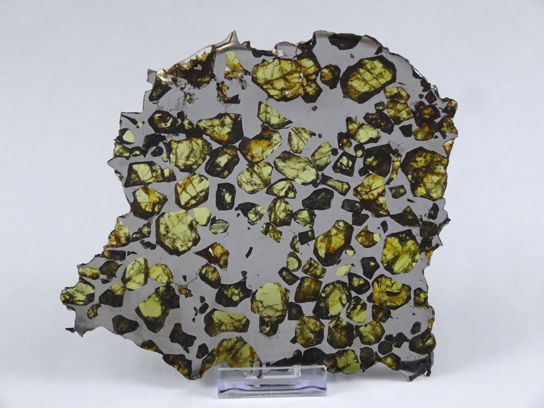
- MESOSIDERITES
These rare meteorites are the result of an impact between a metallic celestial object and an asteroid, which eventually reached the Earth. They are breccias composed of metal-rich parts (nickel - iron) coming from the metallic body and of silicate parts of the asteroid, which have collided.
These different components are clearly visible on the polished plate of the Vaca Muerta meteorite.
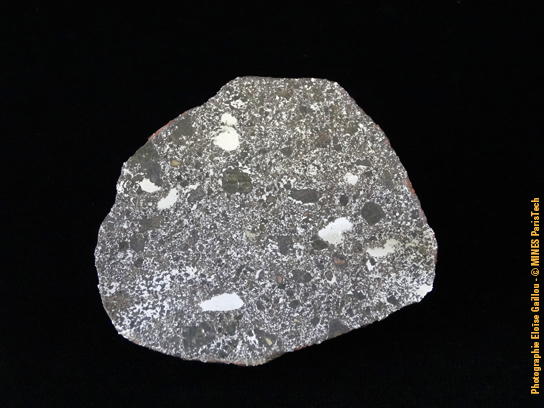
- UREILITES
Ureilites were named after the meteorite fall in Lovo-Urei, Russia in 1886. These are achondrites made up mainly of olivine and pyroxenes. They have the particularity of containing microcrystals of graphite... and diamond! However, do not try to look for the diamonds, they are far too small to be seen with the naked eye. The origin of ureilites is still controversial but they seem to come from a partial fusion of a planetary body.
Our meteorite collection (and our collection in general) can only grow thanks to the generosity of people. Our meteorite donors are renowned scientists and meteorite hunters, who we would like to honor and thank through this exhibition.
PIERRE-MARIE PELE
Pierre-Marie Pelé has been a meteorite hunter since 2003. He has organized numerous research campaigns in France, Spain, Morocco, Tunisia, Libya, Oman, Yemen, Mongolia and the United States. He has made remarkable discoveries, such as the main Villalbeto meteorite fragment fallen in Spain in 2004, or a several meteorites unique for their scientific interest, mainly in the Sultanate of Oman. He also wrote several books on meteorites, the most recent of which is the "Encyclopedia of French meteorites" that includes meteorites from the collection of the MINES ParisTech Mineralogy Museum. In 2008, Pierre-Marie donated 13 unusual and rare meteorites to our museum.
LUC LABENNE
Luc Labenne, a general practitioner who has been practicing for more than 20 years, now dedicates his daily life to meteorites. The search for new meteorites is, for him, a real passion. His meteorites are the subject of advanced scientific research in major universities, institutes and museums around the world.
He is the founder and manager of Labenne Météorites and a member of the Meteoritical Society. He is also co-founder of the P'tits Pueillets d'Étoiles association, whose goal is to introduce hospitalized children to the world of stars. He also actively participates in Fripon / Vigiciel, a network of more than 100 cameras that monitor the sky in order to find meteorites shortly after their fall.
Luc Labenne is the donor of the magnificent lunar breccia visible in the new display called "Touch the Moon" as well as the piece of Martian meteorite to touch in the new display called “Touch Mars”.
ALAIN CARION
Passionate about "pebbles" from the age of five, Alain Carion opens his first shop at 18 years old. In 1982, he acquired his first meteorite. Since then, the passion for these extraterrestrial objects has never left him.
He has the largest private collection of meteorites in France, which was exhibited several times in prestigious museums. He wrote several books on the subject matter. Doctor in Sciences, he is a member of the notorious Meteoritical Society. His son, Louis Carion, with whom he traveled in many deserts in search of these "space rocks", had the chance to travel with Theodore Monod in Mauritania and Egypt.
Alain Carion is the donor of the fragment of the lunar meteorite that the visitors can touch in the new meteorite display.
EDWIN THOMPSON
Edwin Thompson grew up at 3 km away from where the famous Willamette meteorite was discovered in Oregon. It has been a source of inspiration for his life of meteorite hunting. Before the end of his studies in geology and archeology, he made his first trip to Northwest Africa in 1972 at age 18, and lived and worked there for 6 months, also teaching the Berbers how to recognize, find and sell space rocks. Edwin Thompson has lived an exciting life of adventure, looking for extraterrestrial specimens in Morocco, Algeria, Libya or Mauritania. His research has uncovered tons of meteorites and mentored countless now-renowned meteorite hunters. In 2015, Ed published his first novel: He “EarthUnder”.
PIERRE LAMBOTIN ( ? – 1828)
Pierre Lambotin was a trader in Natural History objects, mainly in minerals. Passionate about mineralogy, he took some classes on the subject at the Museum of Natural History and the School of Mines. He then developed the knowledge needed to make models of porcelain crystals, necessary to study crystallography. He has also created suites of wood and ceramics crystal models for Haüy (see the wooden models’ box in room B). Lambotin gave some samples to our museum, including this exceptional fragment of the L’Aigle meteorite.
GILBERT JOSEPH ADAM (1795-1881)
Gilbert Joseph Adam is not a mineralogist or a scientist by profession, but a master advisor to the Court of Auditors. His interest in mineralogy is however important, and he put together a mineralogy collection that will become a reference for several cotypes of minerals. A mineral species, adamite, was named after him by Charles Friedel, curator of the Mineralogy Museum of Paris School of Mines, in 1866, as Adam provided the material for his study. Adam bequeathed his collection to the School, which included about fifty meteorites.
IGNACY DOMEYKO (1802 - 1889)
This generous donor of the museum, former student of the School of Mines (he graduated in 1837) is celebrated in several countries: Belarus his country of birth, Lithuania, Poland, France (3 countries in which he studied) and finally Chile where he lived and taught for 50 years. He embodies the influence of the Paris School of Mines and the French mineralogy of the mid-nineteenth century.
During these 50 years, Ignacy Domeyko sent many samples to the School of Mines, 150 of which are still in the Museum's collection, including many meteorites. He found in the Atacama Desert fragments of the famous meteorite called Vaca Muerta, then called "Taltal Aerolithe".
GABRIEL AUGUSTE DAUBREE (1814-1896)
Former student from the Paris School of Mines, Daubrée was director of the School from 1872 to 1884. Previously he was elected to the Academy of Sciences and was awarded the Chair of Geology at the National Museum of Natural History of Paris. It was during this period that he built one of the world's largest collections of meteorites. He continued this work to a lesser extent at the School of Mines, when he was appointed professor in 1862. Nearly forty of his meteorites are in the collection of the museum of mineralogy.
ECKLEY BRINTON COXE (1839 - 1895)
Eckley Coxe is a former student of the Paris School of Mines, one of the founders of the American Institution of Mining Engineers and leader of a large anthracite mining industry in Pennsylvania (USA). He was also the senator of this state during four years (1880 – 1884). He was a philanthropist, and did not forget his former school by sending many samples of minerals and meteorites. Among these samples given, one will remember the exceptional 500-pound fragment of the Canyon Diablo meteorite that he sent to the School shortly after the prolific discovery of 1891 (main mass of 639 kg, our fragment is the 5th largest fragment know in the world for this meteorite).
ÉMILE BERTRAND (1844 - 1909)
Émile Bertrand is a mining engineer, mineral collector and dealer, and co-founder of the Société Française de Minéralogie (French Mineralogical Society). He is known to have built the first optical microscope for the analysis of thin sections of rocks. He developed, among others, the "Bertrand lens" to observe the interference figures of minerals observed in thin section, method still relevant. He wrote in 1881 "From the application of the microscope to the study of mineralogy", a work that has long been a reference. He discovered many mineral species; the mineral bertrandite was named after him. In 1910, our Museum receives in bequest his collection of 2619 specimens, all of excellent quality, including over twenty meteorites.
ARISTIDES BREZINA (1848 - 1909)
This eminent Austrian mineralogist has sent several dozens of meteorites to our museum, many of which come from the United States, such as those presented in this exhibition. Director of the Department of Mineralogy and Petrography at the University of Vienna, he is at the origin of a classification of meteorites used until the 1920s: the "Rose-Tschermak-Brezina" classification, for the names of its three authors.
Any questions about the museum or the collection ? Contact us
Find all the information to come to the Mineralogy Museum here
Musée de Minéralogie
Mines Paris - PSL
60 boulevard Saint Michel
75006 Paris
OPENING HOURS:
TUESDAY: 10am - 12pm and 1:30pm - 6pm.
WEDNESDAY, THURSDAY, FRIDAY: 1:30pm - 6pm
SATURDAY: 10am - 12:30pm and 2pm - 5pm
Closed on National Holidays, Sundays and Mondays
NEXT CLOSING DAYS:
Wednesday May 1st, 2024
From Wednesday May 8 to Saturday May 11, 2024
Find all our temporary exhibits and special events here
